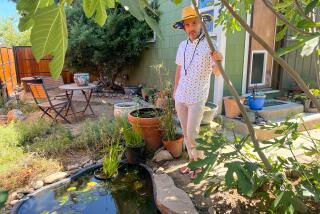GARDENING : Where Simple Stones Find the Ultimate Setting : Landscape: A garden anchored in natural boulders needs no other statuary. Common grasses suddenly stand out.
The best gardens all have time on their side, but timeâs helping hand can be reflected in many ways.
California gardens notably lack the statues and fountains that anchor European gardens in centuries-old traditions. Our landscapes are newer and more natural, and depend less on man-made elements than on trees and stones to lend them character and an air of permanence.
Since the turn of this century, West Coast gardens have profited from a steady infusion of Japanese gardening style, which uses stones as a key feature in landscapes.
Initially the results were copies of gardens in Japan, but gardeners gradually realized that what underlies the Japanese style is simply observations of nature adapted to the scale of private gardens. They found that a hike to the closest canyon stream could be as instructive as a trip to Kyoto, and that native stones in the garden can give as much local flavor as a coast live oak or a field of California poppies.
Landscape designer John Catlin, an Illinois native transplanted to California after World War II, has been a leading proponent of granite in the garden when he wasnât pursuing his other enthusiasms which include bonsai, succulents and bamboo.
The garden of his La Canada home resembles a mountain meadow surrounded by conifers and oaks. Gray granite is everywhere in a variety of forms and functions, ranging from old Japanese stone lanterns to natural stepping stones and boulder-companions for a staggering variety of plants.
Stones with basin-like depressions that hold water are a passion of Catlinâs, and several of them ornament his garden. Some are just as he found them but others have had their basins enlarged by working on them with a stone chisel. Their tiny pools of water reflect a bit of sky and serve to float camellia blossoms, making them eloquently serene garden features.
As perfectly natural as the stones in Catlinâs garden seem, every one of them was hauled in from nearby washes and vacant lots and carefully sited in the garden.
The opposite situation confronted Catlin when Eleanor Carpenter asked him to landscape her new La Crescenta home. The main assets of the lot were a group of olive trees and a generous supply of stones and boulders, some as much as six feet in diameter.
After the choicest stones were picked out, the remaining tons of rock were hauled away. The largest of the retained stones were placed by a skip-loader while the smaller ones were rolled or bullied into place with pry-bars.
Flat stones were used to fashion artful flights of steps that link the various areas of the gently-sloping site. Beside the steps, larger stones provide a foil for the plantings which include many succulents and dry-climate shrubs and perennials.
The counterpoint of plants and stones leads to memorable planting combinations, many of them contrasting grassy, vertical leaves with bulky, somewhat rounded stones. Catlin points out that such a pairing can make a common plant such as fortnight lily (Dietes vegeta) into a striking accent plant.
Grasses, sedges, agapanthus, iris, society garlic, New Zealand flax and day lilies all look well with stones. Catlin also likes to use shallow depressions on the top of stones as planting pockets for miniature clustering succulents such as haworthias, sedums and even some of the smaller aloes for an effect both charming and drought-tolerant.
âThis is where the xerophytic look doesnât have to be so gruesome,â he chuckles.
The landscape designer prefers to stick with the local variety of rock which, in his case, is granite. Shunning white granite, he prefers gray stones with simple grain or interesting striations.
By using only local stone he avoids what he considers the biggest mistake gardeners make with stone--bringing back a single rock from every place they vacation, which gives the garden a cluttered look.
He cautions against rocks with recent, raw-looking fractures in favor of those with edges softened by tumbling in floodwaters. But he also avoids rocks that have been rounded so much they look like âgiant dinosaur eggs.â
Many a good landscape stone has been salvaged from a construction site, or stones can be purchased from building supply outlets. La Canada Rustic Stone (1385 Lincoln Ave., Pasadena; 818-798-7876) sells stones up to two tons for 7 cents per pound plus $35 delivery. When placing a stone, turn it over to figure out which should be the top, bottom, front and back. âOnly occasionally do you find a stone that looks good all the way around,â says Catlin. Stones look more natural when partly buried, especially if overhangs create distracting shadows.






